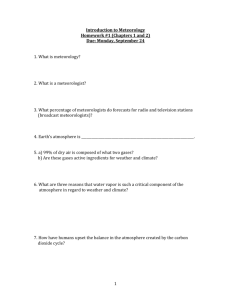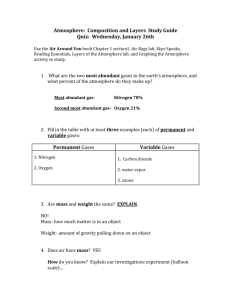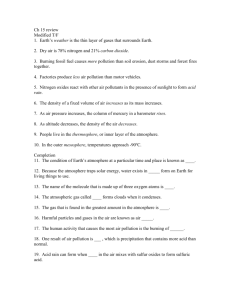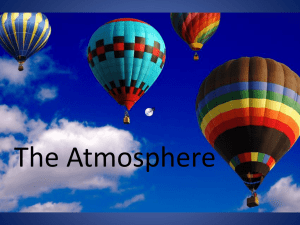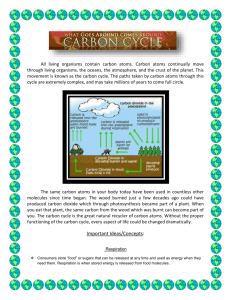CH15_Study_Guide
advertisement
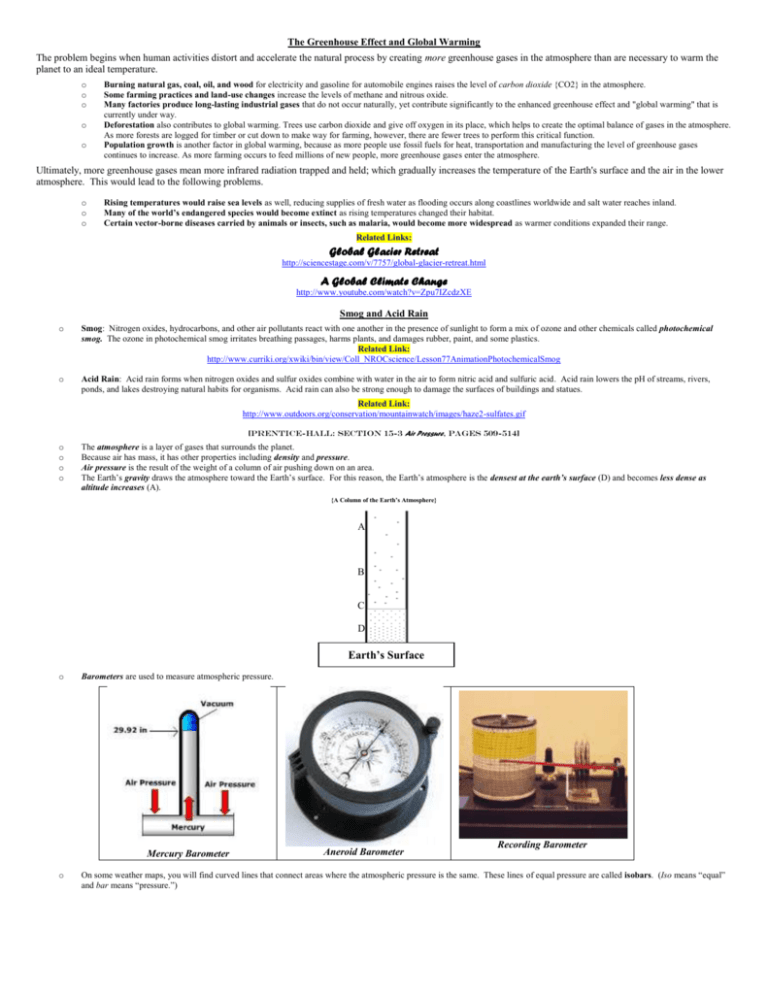
The Greenhouse Effect and Global Warming
The problem begins when human activities distort and accelerate the natural process by creating more greenhouse gases in the atmosphere than are necessary to warm the
planet to an ideal temperature.
o
o
o
o
o
Burning natural gas, coal, oil, and wood for electricity and gasoline for automobile engines raises the level of carbon dioxide {CO2} in the atmosphere.
Some farming practices and land-use changes increase the levels of methane and nitrous oxide.
Many factories produce long-lasting industrial gases that do not occur naturally, yet contribute significantly to the enhanced greenhouse effect and "global warming" that is
currently under way.
Deforestation also contributes to global warming. Trees use carbon dioxide and give off oxygen in its place, which helps to create the optimal balance of gases in the atmosphere.
As more forests are logged for timber or cut down to make way for farming, however, there are fewer trees to perform this critical function.
Population growth is another factor in global warming, because as more people use fossil fuels for heat, transportation and manufacturing the level of greenhouse gases
continues to increase. As more farming occurs to feed millions of new people, more greenhouse gases enter the atmosphere.
Ultimately, more greenhouse gases mean more infrared radiation trapped and held; which gradually increases the temperature of the Earth's surface and the air in the lower
atmosphere. This would lead to the following problems.
o
o
o
Rising temperatures would raise sea levels as well, reducing supplies of fresh water as flooding occurs along coastlines worldwide and salt water reaches inland.
Many of the world’s endangered species would become extinct as rising temperatures changed their habitat.
Certain vector-borne diseases carried by animals or insects, such as malaria, would become more widespread as warmer conditions expanded their range.
Related Links:
Global Glacier Retreat
http://sciencestage.com/v/7757/global-glacier-retreat.html
A Global Climate Change
http://www.youtube.com/watch?v=Zpu7IZcdzXE
Smog and Acid Rain
o
Smog: Nitrogen oxides, hydrocarbons, and other air pollutants react with one another in the presence of sunlight to form a mix of ozone and other chemicals called photochemical
smog. The ozone in photochemical smog irritates breathing passages, harms plants, and damages rubber, paint, and some plastics.
Related Link:
http://www.curriki.org/xwiki/bin/view/Coll_NROCscience/Lesson77AnimationPhotochemicalSmog
o
Acid Rain: Acid rain forms when nitrogen oxides and sulfur oxides combine with water in the air to form nitric acid and sulfuric acid. Acid rain lowers the pH of streams, rivers,
ponds, and lakes destroying natural habits for organisms. Acid rain can also be strong enough to damage the surfaces of buildings and statues.
Related Link:
http://www.outdoors.org/conservation/mountainwatch/images/haze2-sulfates.gif
[Prentice-Hall: Section 15-3 Air Pressure, Pages 509-514]
o
o
o
o
The atmosphere is a layer of gases that surrounds the planet.
Because air has mass, it has other properties including density and pressure.
Air pressure is the result of the weight of a column of air pushing down on an area.
The Earth’s gravity draws the atmosphere toward the Earth’s surface. For this reason, the Earth’s atmosphere is the densest at the earth’s surface (D) and becomes less dense as
altitude increases (A).
{A Column of the Earth’s Atmosphere}
A
B
C
D
Earth’s Surface
o
Barometers are used to measure atmospheric pressure.
Mercury Barometer
o
Aneroid Barometer
Recording Barometer
On some weather maps, you will find curved lines that connect areas where the atmospheric pressure is the same. These lines of equal pressure are called isobars. (Iso means “equal”
and bar means “pressure.”)
What is the barometric
pressure in this location?
________
o
?______millibars
National Weather Service maps indicate air pressure in millibars. One inch of mercury is equal to 33.87 millibars, so 30 inches of mercury is approximately equal to 1,016 millibars.
[Prentice-Hall: Section 15-4 Layers of the Atmosphere, Pages 515-520]
This line
indicates how
temperature
changes as
altitude
increases in the
atmosphere.
As altitude
increases in the
atmosphere, the
atmospheric
pressure
decreases.
Atmospheric Layer
Thermosphere
Mesosphere
Stratosphere
Troposphere
Some Characteristics of Each Layer
The thermosphere extends from 80Km above the Earth’s surface outward into space. It has no definite outer limit. The lower portion of the
thermosphere is referred to as the ionosphere. Ions in the ionosphere reflect radio waves back to Earth. The aurora borealis occurs in the
ionosphere. The upper portion of the thermosphere is referred to as the exosphere. Phone calls and television signals often reach you by
way of communication satellites that orbit the Earth in the exosphere.
Meso means “middle,” so the mesosphere is the middle layer in the earth’s atmosphere. The mesosphere is the coldest layer of the
atmosphere. Most meteoroids burn up in the mesosphere, producing meteor trails.
Strato is similar to stratum, which means “layer” of “spreading out.” The upper stratosphere contains a layer of ozone, the three-atom form
of oxygen. The ozone layer absorbs ultraviolet radiation.
The inner or lowest layer of the Earth’s atmosphere. Tropo means “turning” or “changing.” The conditions in the troposphere are more
variable than in other layers of the atmosphere. The troposphere is where the Earth’s clouds form and weather occurs.
Related Link:
http://earthguide.ucsd.edu/earthguide/diagrams/atmosphere/




